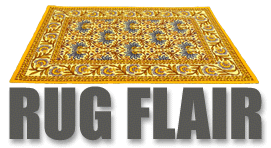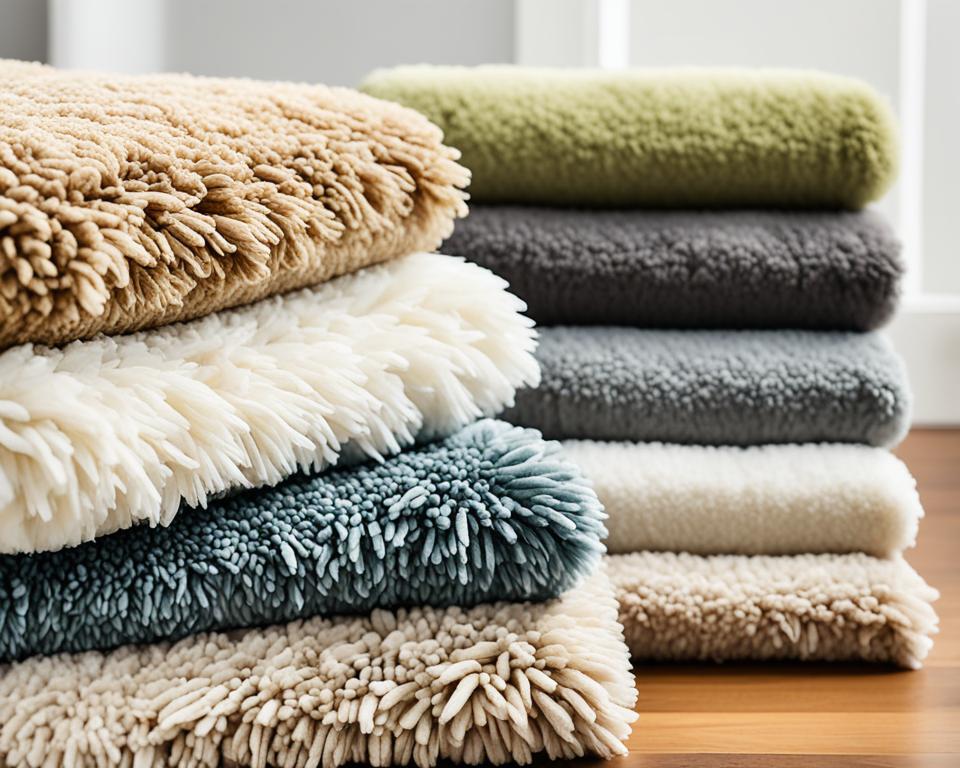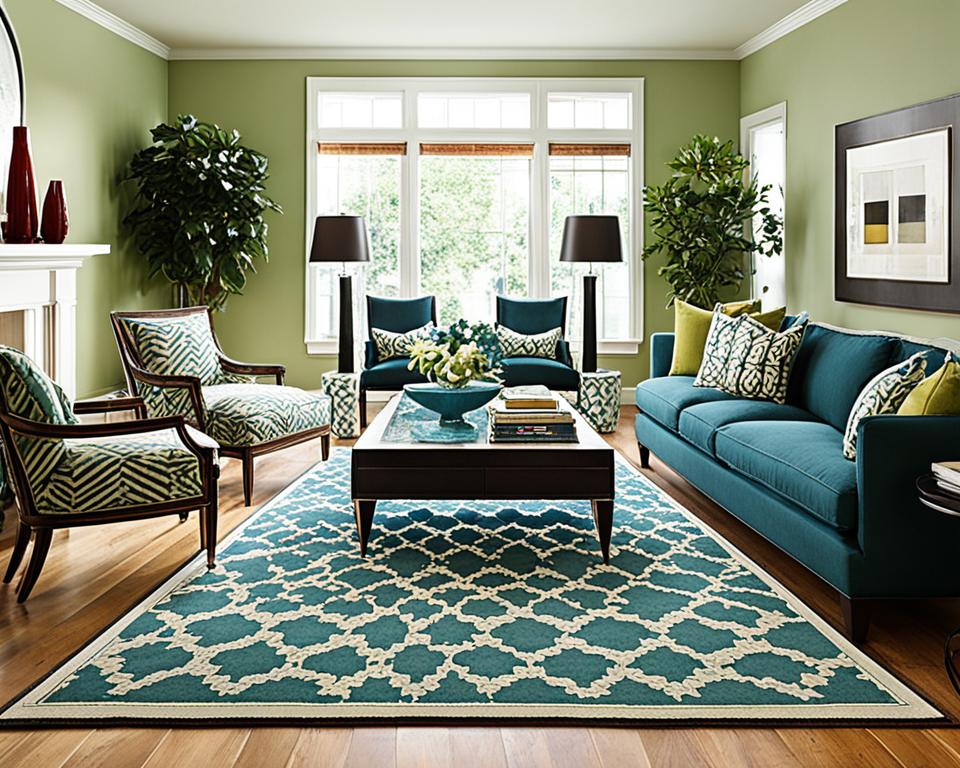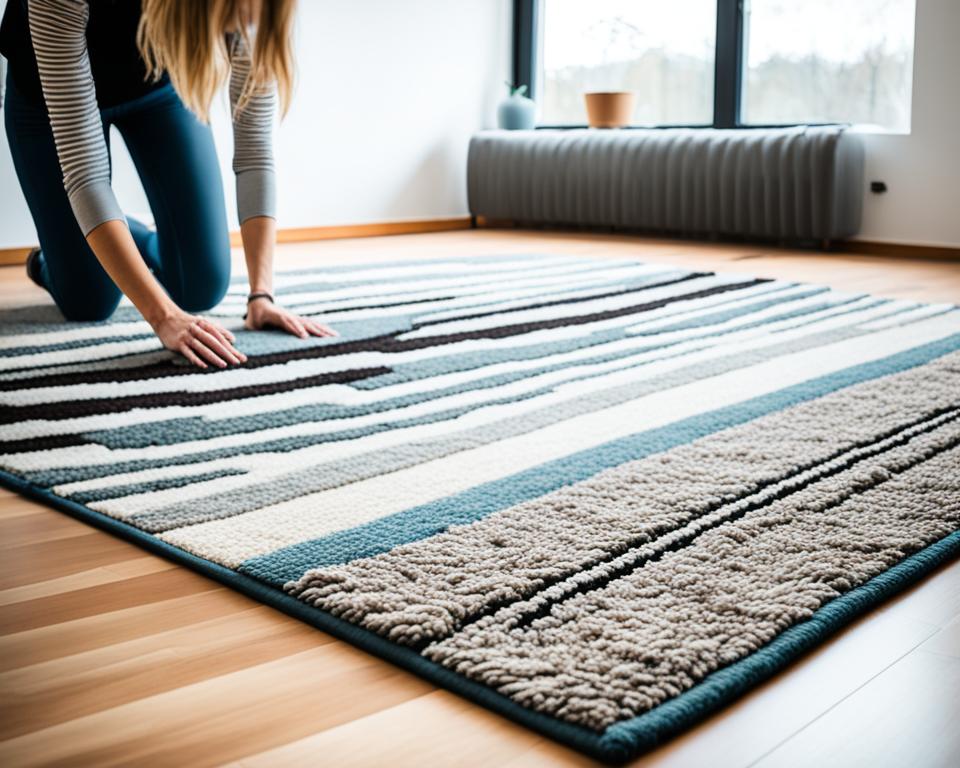When considering the ambiance and comfort of your home, area rugs can add a touch of sophistication and warmth to your space. However, have you ever stopped to wonder, are rugs toxic? Beyond their aesthetic appeal, the rugs underfoot might be silently impacting your home’s indoor air quality and, possibly, your health. While you scour the market for that perfect pattern or texture, it’s crucial to peel back the layers and consider what could be lurking within those fibers—because the health risks of rugs can be woven in more covertly than you’d imagine.
Rugs, though often a background feature, play an integral role in our living spaces. Yet, many carry toxic chemicals in rugs, such as butyl cellosolve, PERC, formaldehyde, and artificial fragrances. These substances aren’t just names on a label; they pose real threats. Long-term exposure to such chemicals has been associated with adverse effects like respiratory issues, skin reactions, and a litany of health complications. It’s about time we shine a spotlight on this relevant issue for your well-being.
Key Takeaways
- Understanding if are rugs toxic is vital to maintaining a healthy indoor environment.
- Some rugs contain harmful chemicals that may pose health risks over time.
- Toxic chemicals in rugs may lead to respiratory difficulties and other health concerns.
- It is essential to assess the indoor air quality and rugs in your living space for a safer home.
- Becoming aware of potential rug toxicity can encourage healthier and more informed purchases.
Understanding the Composition of Common Rugs
Embarking on the quest for the perfect area rug means delving into the myriad of materials available to you. The choices you make reverberate through your living spaces, influencing both aesthetics and health. Our conversation today pivots on understanding what truly lies beneath the lush surface of area rugs and which materials make for the safest rugs for home use.
From sumptuous wool to versatile polypropylene, your carpet’s fabric could be a silent sentinel of sustainability or a catalyst for concern. To arm you with the right information, we’ll uncover the fibers, the potential chemical culprits, and dissect the synthetic vs. natural rug debate.
Materials Used in Rug Production
In terms of fabric selection, rugs often feature an array of materials, each with its own set of attributes and potential drawbacks. Natural rug options, such as wool, cotton, and jute, bring forth materials steeped in nature’s own ingenuity, boasting qualities of resilience and decomposability. However, standing tall in the realm of carpets are synthetic alternatives—like nylon, polyester, and polypropylene—known for their cost-effectiveness and unwavering endurance in the face of spills and foot traffic.
For those seeking non-toxic rug materials, the quest often leads to organic textiles free from pesticides and chemicals that could sully your home’s air and safety. Balancing desires for durability against the need for a healthy environment is paramount when shopping for these domestic staples.
Hazardous Chemicals Found in Some Rugs
However, not all is calm in the kingdom of carpets. Conventional synthetic rugs often come laced with chemicals to boost their stain resistance, longevity, and even flame retardancy. These chemical additives, while serving practical purposes, can insidiously off-gas volatile organic compounds (VOCs) into your serene space, manifesting in headaches, dizziness, and allergy symptoms—one of the less-known hazards peppering the seemingly innocuous landscape of home decor.
The Reality of Synthetic vs. Natural Rugs
In the crossfire between synthetic rugs and natural rug options lie key differentiators—environmental impact, health implications, and life span. While synthetic fibers bid for your attention with their vibrant colors and tenacious textures, the non-toxic rug materials argue their case with inherent hypoallergenic properties and biodegradability. Understanding this dichotomy is essential to make a choice that resonates with both your personal ethos and functional requisites.
Finding safe rugs for home extends beyond mere aesthetics—it’s a commitment to the health of your household and the environment. In the table below, we spotlight the contrasts between synthetic and natural rugs, aiding you in navigating this nuanced marketplace.
| Material Type | Features | Health and Environmental Considerations |
|---|---|---|
| Synthetic Rugs (Polypropylene, Nylon, Polyester) | Durable, stain-resistant, colorfast | Potential VOC off-gassing, less biodegradable |
| Natural Rugs (Wool, Cotton, Jute) | Biodegradable, hypoallergenic, sustainable | Non-toxic, higher eco-friendliness |
As we embrace the narrative of home safety and sustainability, our choice of the rug becomes more than a floor covering—it’s a statement. Staying informed and vigilant is key in selecting a rug that not just decorates but also cares for your home’s ecosystem.
Potential Health Risks of Toxic Chemicals in Rugs
As you adorn your residence with beautiful rugs, it’s important to be cognizant of the potential health risks of rugs. The fibers woven into these pieces may be laden with toxic chemicals that, over time, can gravely impact your health and well-being. The culprits? Substances like formaldehyde and butyl cellosolve are known for their hazardous properties when they become fixtures in your living environment.
Formaldehyde, typically used in the manufacturing of various household products, is also widely prevalent in rug fabrics. Prolonged exposure to this chemical is notorious for causing respiratory problems and has been labeled a human carcinogen. Butyl cellosolve, another chemical commonly found in carpet cleaning agents and de-greasers, can lead to skin irritations and more grave ailments upon long-term contact.
Your health should not be compromised by your choice of home decor. Hence, the shift towards eco-friendly rug options is not just a trend but a health imperative. Choosing non-toxic rug materials can significantly mitigate the risk of chronic health issues associated with toxic chemicals. With a plethora of non-toxic alternatives on the market today, safeguarding your home against these invisible threats has never been easier.
Did you know? Non-toxic rugs often leverage natural materials like organic cotton, wool, or jute, negating the need for chemical treatments and thus abolishing the associated health hazards.
Opting for rugs made of natural fibers can do more than elevate your home’s aesthetic. They can be the bulwark that protects you and your loved ones from harmful exposures. Let’s dive into the distinct advantages and safety profiles of popular rug materials used today:
| Material | Advantages | Safety Profile |
|---|---|---|
| Wool | Naturally stain-resistant, durable, eco-friendly | Low VOC emissions, hypoallergenic |
| Cotton | Soft, versatile, sustainable | Chemical-free options available, biodegradable |
| Jute | Strong, sustainable, rustic appeal | Non-toxic, low environmental impact |
| Synthetics (Nylon, Polyester, Polypropylene) | Affordable, stain-resistant, vivid colors | Potential for high VOC emissions, not biodegradable |
In conclusion, empowering yourself with knowledge about the materials and chemicals in your rugs can dramatically influence your health and comfort. Embracing non-toxic rug materials not only aligns with eco-friendly living but also proactively protects against the insidious health risks these silent aggressors may furnish. Remember, the rug you choose is the foundation upon which your indoor sanctuary is built—choose wisely and healthfully.
Indoor Air Quality and the Role of Rugs
As we cozy up our homes with various decor, we seldom pause to consider how these aesthetic choices, like rugs, can affect the indoor air quality. When it comes to indoor comfort, sustainable rug choices not only showcase our style but also have the potential to impact our health through the presence of airborne rug toxins. Let’s explore the relationship between the rugs we select and the air we breathe within our homes.
How Rugs Affect Indoor Air Environment
It may surprise you to learn that your cherished area rug could play a significant role in the quality of air circulating through your living spaces. Rugs can act as reservoirs for dust, allergens, and microorganisms that, when disturbed, become part of the air you breathe. But beyond these particulates, the chemical makeup of some rugs is cause for concern. Synthetic rugs, in particular, are often treated with chemicals to enhance their stain and water-resistant properties—advantages that, unfortunately, come with a hidden cost.
Factors That Contribute to Airborne Rug Toxins
Several factors can increase the presence of airborne toxins from rugs in your home environment. The type of material and chemical treatments applied to the rug undoubtedly play a pivotal role. Temperature and humidity also factor in, often accelerating the off-gassing process, whereby volatile organic compounds (VOCs) are released. Let’s dive deeper into these contributing elements that could be subtly undermining the purity of your living space’s air.
Understanding these factors arms you with the knowledge to make more informed choices. Here’s a summarized comparison of how different types of rugs could be influencing the very air you depend on:
| Rug Type | Air Quality Impact | Factor Influencing Toxins |
|---|---|---|
| Synthetic Rugs | High potential for VOC off-gassing | Chemical treatments, manufacturing processes |
| Wool Rugs | Low VOC emission, natural filtration | Presence of natural lanolin oil, less chemical processing |
| Cotton/Jute Rugs | Minimal chemical off-gassing, traps fewer allergens | Use of natural, often organic fibers |
By choosing sustainable rug choices that prioritize natural, untreated materials, you take a significant step towards enhancing your home’s air quality. This proactive choice helps reduce the prevalence of airborne rug toxins, contributing to a healthier indoor environment for you and your family.
Eco-Friendly Rug Options for Safer Interiors
As your journey for a harmonious and healthy home continues, the path leads you toward eco-friendly rug options. Anchoring the rooms in your abode with sustainable choices can transform the indoor landscape into a safer, toxin-free environment. Beyond their functional role of enhancing comfort and style, non-toxic rug materials serve as guardians to your indoor air quality, quietly preserving the wellbeing of everyone in the household.
The cornerstone of these sustainable pieces lies in their composition. By favoring organic materials like wool, jute, and cotton, renowned for their lack of harmful chemical treatments, you can ensure that your choice is contributing positively to both the environment and your home’s health profile. Opting for rugs from organic rug brands that carry certified eco-labels further cements your commitment to environmental responsibility, safeguarding the earth and its inhabitants.
Let’s explore an array of eco-conscious rug choices that will not only bring visual warmth to your floors but also peace of mind, knowing they pave the way for a cleaner, greener lifestyle:
- Organic Wool Rugs: Embrace the natural resilience and luxurious feel of organically farmed wool rugs; a choice that delivers both comfort and a promise of sustainability.
- Jute Rugs: Celebrate the earthy aesthetics of jute rugs, which are often responsibly harvested and crafted, personifying a commitment to ecological integrity.
- Organic Cotton Rugs: Delight in the soft touch and versatile designs of organic cotton rugs that favor a farming process free of pesticides and chemicals.
To delineate the merits of these earth-friendly selections, here’s a table offering a closer look at how each material contributes to a cleaner, safer living space:
| Material | Eco-Friendly Qualities | Certifications to Look For |
|---|---|---|
| Organic Wool | Biodegradable, renewable resource | Global Organic Textile Standard (GOTS) |
| Jute | Highly sustainable, requires little to no pesticides | OEKO-TEX, Fair Trade |
| Organic Cotton | Grown without synthetic additives, conserves water usage | Global Organic Textile Standard (GOTS) |
These ecologically and ethically attuned options are integral players in a global movement toward sustainable living. As you stand before the panorama of rug choices, consider how the threads of each piece entwine environmental stewardship with domestic bliss. By selecting an eco-friendly rug, you’re not only adorning your floor but also affirming a pledge to advocate for a healthier planet.
Remember, the magic of an inviting home is not solely woven into the colors and patterns that meet the eye—it resides, too, in the purity of each element that constitutes your inner sanctuary’s foundation. Choose eco-friendly, choose wisely, choose a future where both your interiors and the Earth can breathe with ease.
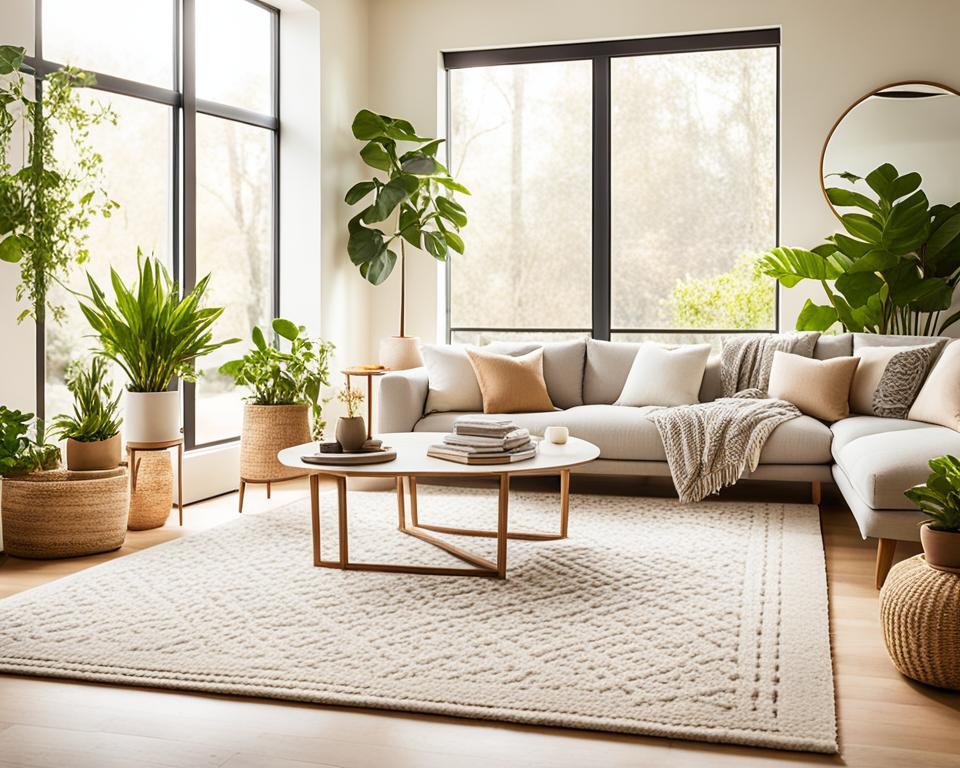
Are Rugs Toxic: Analyzing the Impact of Non-Toxic Rug Materials
Investing in the right rug goes beyond aesthetics; it touches the realm of health and safety within your haven. As concerns about toxic home products rise, attention has turned toward understanding how non-toxic rug materials counteract the potential health risks rugs may harbor. Let’s unpack the benefits non-toxic rugs bring to our homes and how certifications play a role in ensuring their safety and reliability.
Benefits of Choosing Non-Toxic Materials
Opting for non-toxic rug materials is an investment in the health of your home’s ecosystem. These rugs provide a sanctuary free from the anxiety of exposing your family to harmful chemicals. Materials such as organic wool, cotton, and jute not only preserve indoor air quality but also introduce hypoallergenic and sustainable elements into your living space. The absence of volatile organic compounds (VOCs) in non-toxic rugs means you’re less likely to encounter dangers such as respiratory issues, skin irritations, and long-term health complications.
Remember, a non-toxic rug is a cornerstone of a healthy home. By selecting these options, you are creating a safe haven for your loved ones to play, rest, and create lasting memories without the concern of health risks of rugs.
Understanding Certifications and Standards for Rugs
When navigating the maze of rug selections, certifications act as beacons of trust, signaling a commitment to health and the environment. The Global Organic Textile Standard (GOTS) is prestigious, indicating that a rug meets stringent criteria, including the prohibition of toxic dyes and harmful chemicals. Another notable certification is GREENGUARD, which ensures that products like rugs fulfill rigorous chemical emissions standards, contributing to cleaner and safer air inside your home.
While certifications provide peace of mind, let’s also pay homage to brands taking steps toward responsible craftsmanship. Authentic eco-friendly rugs might be backed by labels like OEKO-TEX, which tests for substances detrimental to health, ensuring that are rugs toxic no more. These labels serve as guides to help you make informed and conscientious choices for non-toxic rug materials that align with your values.
In your pursuit of a non-toxic home environment, keep these insights at the forefront of your decision-making. Your proactive approach to selecting safe rugs can sculpt a healthier, more harmonious living space and set a standard for mindful living.
Are rugs toxic? Not if you choose wisely. With informed decisions and a discerning eye for certified non-toxic rugs, a healthier, more vibrant home is beautifully within reach.
Toxic Chemicals in Rugs: What You Need to Know
When you think about sprucing up your home with a new rug, you’re likely envisioning color, design, and comfort. However, it’s critical to also consider how your choice affects your indoor air quality and rugs’ contribution to it. Hidden within the threads and weaves could be toxic chemicals in rugs that pose unforeseen health risks of rugs.
Most may know the dread of a headache or dizziness after laying down a new rug. These symptoms can sometimes be the early warnings of off-gassed volatile organic compounds (VOCs), like butyl cellosolve and perchloroethylene (PERC), seeping into your home’s air. These VOCs are not merely unpleasant odors; they represent substances that could have a more significant, long-term impact on your health.
| Chemical | Potential Health Risks | Common Uses in Rugs |
|---|---|---|
| Butyl Cellosolve | Headaches, nausea, skin irritation | Carpet cleaning solutions, de-greasers |
| Perchloroethylene (PERC) | Breathing difficulties, dizziness, long-term exposure risks | Spot removers, dry cleaning solutions |
| Other VOCs | Allergic reactions, respiratory issues | Adhesives, stain-resistant treatments |
The dialogue surrounding these risks is not to foster alarm but to empower you to make informed decisions for a healthier home environment. To reiterate, it’s not just about selecting a rug that visually appeals to you—a mindful choice can be a protective barrier against avoidable exposures.
Knowledge is power. Being informed about the toxic chemicals frequently found in rugs allows you to steer clear of potential hazards and cultivate a safer indoor space for you and your family.
Thankfully, you’re not without options. The market has seen a rise in chemical-free rug choices designed with both your health and the environment in mind. As increasing numbers of consumers ask, “Are rugs toxic?” manufacturers are responding with a broader availability of non-toxic rug materials and eco-friendly alternatives.
To maintain the sanctity of your indoor air quality, always remember to scrutinize the labels for indications of harmful chemicals and prioritize rugs that boast non-toxic credentials. A few measures can go a long way in ensuring what lies beneath your feet supports a clean and safe home.
How to Identify and Avoid Toxic Rugs
With the rising awareness of indoor health hazards, one crucial question to ask before you lay down a new area rug is, “Are rugs toxic?” In your pursuit of safe rugs for home, understanding the labels and materials that contribute to non-toxic living spaces becomes pivotal. Here’s how you can ensure the rugs you select are free from harmful substances.
Important Label Information for Rug Safety
When selecting non-toxic rugs, the first line of defense is the label. Manufacturers often indicate the safety of their products through labeling. For instance, look for indications of rugs being labeled as environmentally friendly, chemical-free, or bearing certifications that verify the absence of toxic chemicals. These labels are not mere marketing terms; they are assurances that suggest conscientious manufacturing and safer products for your home.
Tips for Selecting Non-Toxic Rugs
Going beyond labels, selecting non-toxic rugs revolves around being proactive and informed about the materials and chemicals typically used in rugs. Prioritize rugs made from non-toxic rug materials like wool, cotton, or bamboo, which have a reputation for being more natural and less reliant on chemical treatments. It’s worth considering sustainability-certified options that reinforce your commitment to a health-conscious home environment.
In addition to material selection, take into consideration natural DIY cleaning methods. These alternatives contribute to maintaining the quality of your indoor air post-cleaning, further mitigating the risk of exposure to detrimental chemicals often found in conventional cleaning products. Whether you opt for handheld steam cleaners or homemade vinegar and baking soda solutions, these eco-friendly choices align with an organic lifestyle and are gentle on non-toxic rugs.
Finally, ensure proper ventilation when installing new rugs or cleaning existing ones. A well-ventilated space aids in the dispersion of any residual VOCs, thus enhancing your home’s overall air quality. By adopting these prudent measures in selecting and maintaining your rugs, you’re laying the groundwork for a safer, toxin-reduced living environment.
The Hidden Health Impacts of Rug Off-Gassing
As you unroll your new rug, picturing the comfort and charm it will add to your home, it’s vital to recognize an unseen factor that can affect your living space: rug off-gassing. This subtle process can introduce volatile organic compounds (VOCs) from the rug into your environment, silently contributing to the health risks of rugs.
The aesthetic pleasure of a rug could be overshadowed by concerns about the indoor air quality and rugs. Off-gassing can happen with many types of rugs, particularly those made with synthetic fibers and backed with chemical-heavy adhesives. The VOCs they emit may aggravate or even cause health issues such as allergies, respiratory concerns, and skin irritations.
Be wary; the fresh scent of a new carpet often masks the more insidious nature of these compounds. Though not immediately perceptible to you, rug off-gassing can persist for months, slowly emitting a cocktail of chemicals into the air you breathe daily.

Awareness is the first step in combating the undesirable effects of these emissions. It’s not just about selecting a rug for its pattern or plushness—consideration of its material and construction is paramount. Opting for natural fibers like wool, cotton, or jute can greatly reduce the potential for off-gassing.
Here are some practical tips to help speed up the off-gassing process, thereby improving your indoor air quality:
- Ventilate your space well after introducing a new rug to encourage the dispersal of emitted VOCs.
- Use air purifiers with activated carbon filters designed to capture chemicals and odors.
- Consider using a dehumidifier to reduce humidity and prevent the accumulation of moisture, which can exacerbate VOC emission.
| Material | Off-Gassing Potential | Suggested Action |
|---|---|---|
| Synthetic (e.g., Nylon, Polypropylene) | High | Increase ventilation, use air purifiers |
| Natural Wool | Low | Regular vacuuming, maintain low humidity |
| Cotton/Jute | Minimal | Use of natural cleaning products |
By taking control of the selection process and the post-purchase environment, you can minimize the impact of rug off-gassing on your indoor air quality and health. Remember, your rug choices should be comfortable not just underfoot, but for the atmosphere of your home too.
Safe Rugs for Home: Choosing the Right Options for Your Space
Creating a health-conscious haven starts from the ground up with safe rugs for home. The quest for aesthetic harmony must never compromise the sanctuary of your indoor environment. Therefore, for the eco-savvy and health-conscious consumer, delving into the world of non-toxic rug materials becomes more than an afterthought—it’s a deliberate choice for well-being.
Identifying Rug Choices for Health-Conscious Consumers
Not all rugs are created equal, especially when it comes to your health. The contemporary market offers a diverse palette of options, each with its perks and pitfalls. To steer clear of the health risks of rugs, your eye should linger on labels asserting non-toxicity and eco-friendliness. Wool, cotton, and bamboo are sterling examples of non-toxic rug materials, grown free of pesticides and processed without harmful chemicals—ideal choices for those who place health at the forefront.
Opting for rugs made from natural fibers is not just a style choice, it’s a lifestyle choice that puts your health first.
It’s not just about opting for non-toxic rug materials; it’s deducing what lies behind their soft façade. Rugs approved by reputable certifications such as the Global Organic Textile Standard (GOTS) or carpets bearing the OEKO-TEX® label ensure that your decorative choices contribute positively and sustainably to your living domain.
Best Practices in Rug Placement and Usage
While selecting the right non-toxic rug materials is pivotal, their placement and upkeep are equally critical. Rugs should not be an afterthought in areas of repose or high traffic. Securely situating your rug with anti-slip pads can prevent accidents, while adhering to a routine cleaning schedule with natural detergents can maintain the non-toxic integrity of your rug. Moreover, keeping your rugs away from high humidity areas can prevent the growth of mold, a silent yet harmful guest to any home.
| Material | Placement Consideration | Cleaning Practices |
|---|---|---|
| Wool | Avoid direct sunlight to prevent fading | Regular vacuuming and spot cleaning with mild detergent |
| Cotton | Best in low moisture areas to prevent mildew | Machine washable options available—check care labels |
| Bamboo | Works well in airy, dry spaces | Use a damp cloth for spot cleaning, air dry thoroughly |
In conclusion, aligning your rug selections with health-conscious rug choices doesn’t require compromise. It involves a harmonious blend of style, substance, and a commitment to maintaining a safe and healthy environment. Let your flooring echo your values and cradle your footsteps amidst beauty that cares for you and your family.
Child and Pet Safety: Ensuring Your Rugs Aren’t Harming Loved Ones
As you adorn your living spaces with beautiful decor, it’s essential to ponder the surfaces where your children and pets spend much of their playtime. The softness of a rug underfoot can be deceiving, as some rugs conceal harmful toxins that could pose health risks. Opting for safe rugs for home, specifically those free from hazardous chemicals, is a critical step in creating a secure environment for your most vulnerable loved ones.
When it comes to children and pets, their close contact with the floor makes them particularly susceptible to the toxins that may be embedded in traditional rugs. Thus, choosing non-toxic rug materials is not merely a recommendation; it is a necessity. These materials ensure that your indoor environment supports the well-being of your entire family, with a special focus on those who are most at risk.
Did you know? Rugs certified as non-toxic are less likely to contribute to indoor air pollution, which means cleaner breathing for everyone in your home.
Take a moment to reflect on the health risks of rugs crafted with questionable materials, and use this awareness to guide your purchasing decisions. To help protect your children and pets, consider the following table that offers a comparison of common rug materials, highlighting those that are safe and suitable for your home:
| Material | Safety for Children and Pets | Recommended Use |
|---|---|---|
| Wool | Excellent – Natural, hypoallergenic | Play areas, bedrooms |
| Cotton (organic) | Excellent – Soft, non-irritating | Living rooms, nurseries |
| Bamboo | Good – Durable and easy to clean | Entryways, dining areas |
| Synthetic (Polypropylene, Nylon) | Varies – Some are treated with chemicals | Select with caution and proper certification |
As you sift through varying rug options, keep your priorities aligned with providing a safe haven for those you cherish most. By selecting carpets certified as non-toxic rug materials, you’re not only enhancing the visual appeal of your residence but also embracing a lifestyle that puts health and safety at the forefront. The conscious choices you make today will pave the path to a healthier future for the most playful members of your household.
In your pursuit of tranquility and comfort, the safety of your dear ones should remain paramount. Rugs enveloping your floors can, and should, be sources of joy, not concern, within the very walls meant to protect them. With careful selection, your rugs will be synonymous with safety, and your home a bastion of well-being. Let’s ensure that each step taken, be it on two feet or four paws, is cushioned by care and consideration.
Sustainable Rug Choices for Environmentally Aware Households
If you’re committed to an environmentally conscious lifestyle, one of the integral elements in your home decor should be sustainable rug choices. These not merely add aesthetic value but also echo your values of stewardship for the planet. Let’s delve into the impact of sustainable rugs on environmental sustainability and shine a light on the advantages of opting for organic rug brands.
Impact of Rugs on Environmental Sustainability
Every rug tells a story, not just of design but also of its journey from raw material to your home. Traditional rug-making processes often involve materials and practices that aren’t kind to the environment. By choosing eco-friendly rug options, you’re selecting pieces that are crafted with renewable resources. Materials such as wool, jute, and organic cotton tend to have a smaller ecological footprint, particularly when compared to synthetic counterparts.
Environmentally conscious consumers are increasingly turning to rugs that champion sustainability at every step, including the humane treatment of animals for wool, the absence of harmful pesticides in cotton farming, and the use of biodegradable materials like jute. Not only do these materials offer environmental benefits, but they’re also durable and timeless, ensuring a rug that you can treasure for years to come.
Spotlight on Organic Rug Brands and Their Advantages
When it comes to choosing a rug, you have the power to support organic rug brands dedicated to ethical practices and reduced environmental impact. These brands often hold certifications like the Responsible Wool Standard, which ensures that wool is sourced from farms with a progressive approach to managing their land and practicing the ethical treatment of sheep.
Organic rug brands understand that a beautiful rug doesn’t have to come at the expense of the earth. They employ eco-friendly practices in their production, like using natural dyes and minimizing waste. The advantages of choosing these brands include not only decreasing your home’s environmental impact but also introducing healthier living spaces free from the volatile organic compounds (VOCs) found in many conventional rugs.
| Brand | Sustainability Practices | Eco-Certifications |
|---|---|---|
| Organic Weave | Handmade with organic materials, toxin-free dyes | GOTS Certified |
| Earth Weave | Natural wool, no chemical treatments | Bio-Floor™, No VOCs |
| Hook & Loom | Recycled and eco-cotton rugs, no dyes or chemicals | Eco-Label Certified |
By choosing rugs from brands like these, not only do you put the environment first, but you also support responsible businesses. With this knowledge, your search for a new rug can align perfectly with your commitment to our planet’s health and the push for a sustainable future within the home.
Conclusion
As you stand at the crossroads of beautifying your home and safeguarding your health, remember that the rugs underfoot should merit cautious selection and consideration. Unearthing whether are rugs toxic is crucial for maintaining a sanctuary that not only reflects taste but also fortifies wellness. Through this exploration, we’ve uncovered the silent narrative of rugs—their hidden impact on health and air quality—and provided a framework for you to foster safer, more sustainable living spaces.
Summarizing Health Considerations in Rug Selection
Your choice can transform areas into non-toxic retreats by opting for non-toxic rug materials. By acknowledging and acting upon the knowledge of what constitutes safe rugs for home, you’re empowered to curate spaces that are visually and viscerally nurturing. The fibers that grace your floors should be free from the shadows of toxic threats, allowing every room to be a clean, breathable environment that complements your family’s lifestyle and values.
Moving Towards Healthier Homes with Non-Toxic Rugs
You’re not just purchasing a rug; you’re laying down a cornerstone for health-oriented living. Make the conscious decision to select safe rugs for home that align with the aspiration for wholesome spaces. The move towards organic brands and materials shuns the adverse impacts of harmful toxins, crafting havens brimming with purity and peace. Embrace the ethos of environmental care and personal well-being with every rug choice and revel in the tranquility of a thoughtfully designed, toxin-free home.
FAQ
Are all rugs toxic to some degree?
Not all rugs are toxic; it depends on their materials and manufacturing processes. Rugs made of natural fibers without chemical treatments are generally non-toxic, whereas some synthetic rugs may contain harmful chemicals that pose health risks.
What are the health risks associated with toxic chemicals in rugs?
Toxic chemicals in rugs can lead to respiratory problems, skin irritations, allergies, and long-term issues such as chronic disorders due to prolonged exposure to substances like formaldehyde and volatile organic compounds (VOCs).
How do rugs affect indoor air quality?
Rugs can significantly impact indoor air quality through the off-gassing of VOCs and other airborne toxins. Chemical treatments and the synthetic materials often used in rugs can release these harmful substances into the air, potentially affecting human health.
What are some eco-friendly rug options to consider?
Eco-friendly rug options include those made from natural and organic materials like wool, jute, cotton, and bamboo. Additionally, rugs certified by eco-labels such as the Global Organic Textile Standard (GOTS) or GREENGUARD ensure lower emissions of VOCs and minimal use of toxic chemicals.
Can selecting non-toxic rug materials really make a difference in the home?
Absolutely. Non-toxic rug materials can greatly improve indoor air quality and reduce potential health risks, making for a safer, healthier living environment, especially for children and pets who are in close contact with these surfaces.
How can I tell if a rug has toxic chemicals?
Check for specific labels or certifications that indicate a rug’s safety. Look for tags that list the rug as environmentally friendly, chemical-free, or those that feature certifications endorsing the absence of hazardous substances.
What steps can I take to reduce my exposure to rug off-gassing?
To minimize exposure to off-gassing, choose rugs with low VOC emissions, provide adequate ventilation, and, if possible, let new rugs air out before introducing them into confined living spaces.
How do I select safe rugs for my home?
Choose rugs made from natural fibers without chemical treatments. Verify the manufacturer’s information about the rug’s materials and production methods, opt for products with reliable non-toxic certifications, and be mindful of ethical and sustainable production practices.
What considerations should I have for child and pet safety when it comes to rugs?
Select rugs that are certified as non-toxic and made with natural materials, as children and pets are more vulnerable to the effects of toxic chemicals. Avoid rugs with treatments or coatings that can cause adverse health effects.
How can my choice of rug benefit the environment?
By choosing sustainable rug options, you support renewable and ethical sources of materials, reduce your ecological footprint, and promote eco-friendly practices in the rug industry, all contributing to a healthier planet.
